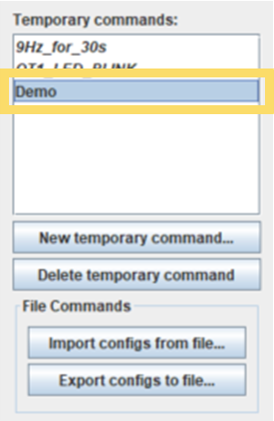Edit Temporary Command
- Open the project in the QSP.
- In the menu bar at the top, open the Deployment menu and select Temporary command editor to open the editor window.
-
From the list of temporary commands on the left, select the one that you want
to edit.
Note: The default temporary commands (in italics) cannot be edited.

-
Use the panel on the right to edit the temporary command as needed.
Note: All of the changes made will be saved automatically.
Table 1. Available Temporary State Parameters Parameter Available Options Transmit rate 0.1 Hz, 0.2 Hz, 0.25 Hz, 0.33 Hz, 0.5 Hz, 1 Hz, 2 Hz, 3 Hz, 4 Hz, 5 Hz, 9 Hz, 17 Hz, 33 Hz, 50 Hz Response mode Fast, Balanced, PowerSave Transmit power Low (-12), Medium (-6), High (0), Maximum (6) State timeout 0 s, 1 s, 4 s, 10 s, 20 s, 30 s, 1 min, 5 min, 10 min, 30 min, 1 h, 2 h, 4 h, 8 h, 24 h Trigger sensitivity 0...15, Off Payloads STA (always selected), TRIG, BAT, ACC, DEV (optional) IO Settings (Output 1, Output 2, Output 3, Output 4) AlwaysOff, AlwaysOn, BlinkSlow, BlinkFast User data User data (3 bytes) Note: IO Settings - There are four digital outputs that can be configured with the temporary command editor of the QSP. These can be used to control tag behaviour (e.g. blinking LED). The available output states in the temporary command editor are: AlwaysOff, AlwaysOn, BlinkSliw, BlinkFast. For example, Output 1 can be used to control the LED on the Quuppa Tag QT1-1.Note: User Data - Custom data can be sent to the tag using the user data field in the QSP's temporary command editor. This can be used for example to control the behaviour of 3rd party tags. If not used, it is set to 0x000000.Note: Battery life estimation - Select model QT1-Tag-module and change the battery capacity to estimate the battery life of 3rd party tags based on the QT1 module or similar hardware.
